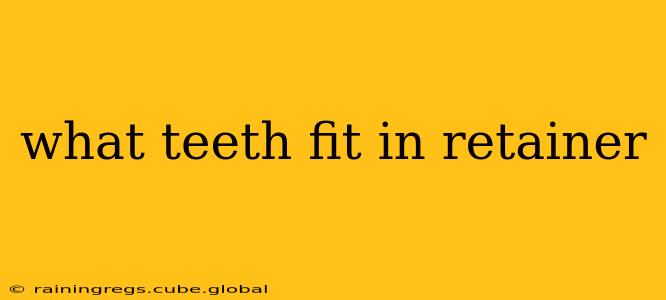What Teeth Fit in a Retainer?
A retainer's purpose is to hold your teeth in their new, corrected positions after orthodontic treatment (braces or Invisalign). Therefore, all the teeth that were moved during your orthodontic treatment should fit into your retainer. This typically means most, if not all, of your upper and lower teeth. Let's break down some specifics:
What if some teeth didn't move?
If some teeth didn't require movement during your orthodontic treatment, they might not be directly engaged by the retainer's design. However, the retainer's overall structure will still maintain the proper spacing and alignment of all your teeth. Think of it as a supporting framework; even if some teeth aren't directly "held" by a specific part of the retainer, the general structure prevents shifting.
Do retainers fit all teeth equally?
No, the fit isn't uniform across all teeth. The retainer's design is custom-made to precisely fit your individual tooth positions and gum line. It will typically have tighter contact around the teeth that moved the most during your orthodontic treatment, ensuring stability. Other teeth will still be positioned within the retainer's structure, benefiting from the overall support.
What types of retainers are there, and how do they fit?
There are several types of retainers, each with a slightly different fit:
- Hawley retainers: These classic retainers have a metal wire encompassing the teeth and an acrylic base that sits against the palate (upper) or gumline (lower). The wire engages most of the teeth.
- Essix (clear) retainers: These are thin, clear plastic appliances that fit snugly over the teeth. They cover the teeth more uniformly, providing gentle pressure for retention.
- Fixed retainers (bonded retainers): These are thin wires bonded directly to the back of your teeth, usually the lower incisors. These don't fit "over" the teeth in the same way as Hawley or Essix retainers. They're essentially permanent fixtures designed to maintain stability.
How do I know if my retainer fits correctly?
If your retainer doesn't fit correctly, you should contact your orthodontist immediately. Signs of a poor fit include:
- Discomfort: Significant pain or pressure could indicate a problem. Minor discomfort is normal for the first few days, but intense pain isn't.
- Loose fit: If the retainer feels loose or wobbly, it won't provide adequate support.
- Difficulty inserting or removing: While it might take some getting used to, significant difficulty suggests a potential fit issue.
- Irritation: Prolonged irritation or sores in your mouth could indicate pressure points or ill-fitting areas.
Your orthodontist is the best resource for assessing retainer fit. They can adjust or replace your retainer as needed.
What happens if my retainer doesn't fit?
A poorly fitting retainer can lead to teeth shifting back to their original positions, undoing the work of your orthodontic treatment. This is why it's crucial to seek professional help if you suspect a fit issue.
Remember, proper retainer use is key to maintaining your straight smile after completing orthodontic treatment.
Disclaimer: This information is for general knowledge and should not be considered medical advice. Always consult your orthodontist for any questions or concerns regarding your retainer.
